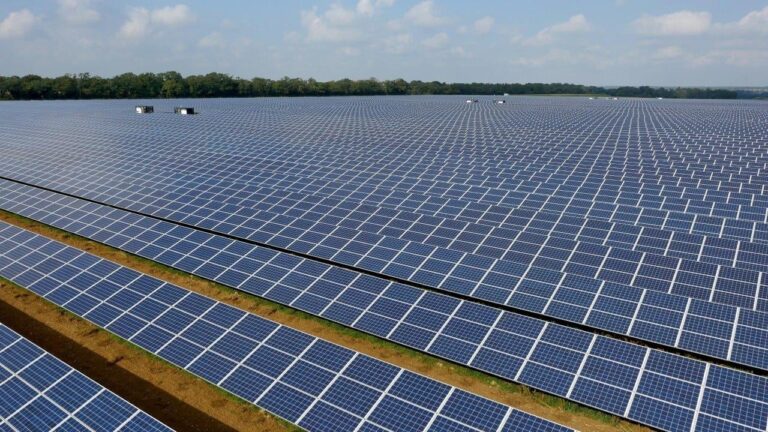Britain has witnessed a steady increase in solar energy adoption in recent years. The combination of government incentives, technological advances and growing environmental awareness have fueled growth in the domestic and commercial markets.
We have also seen new policy commitments, with the new government promising a “rooftop revolution”, which aims to triple Britain’s solar capacity by 2030. Since taking office, the government has also given the green light to 2 GW of solar farm capacity – more than the last 14 years combined. With even more eco-friendly policies set to come into effect in the coming years, there is tremendous optimism about the country’s future and its potential to become a leading green power.
By August 2024, dependence on fossil fuels dropped to less than a fifth of all electricity generated nationwide. The National Grid’s latest renewable energy report shows that 4.9% of Britain’s energy is attributable to solar – a figure that has undoubtedly increased since the report was published in 2023.
In terms of power produced by solar energy, data from August 2024 also shows that Britain has installed over 16.9 GW of solar capacity, enough to power 2.8 million British homes annually.
We also see that large-scale solar farms are becoming increasingly common in rural environments. The latest government data shows that there are 1,336 operational solar farms in Britain, and if we take into account projects awaiting construction or planning permission, there will be well over 4,000 solar farms in Britain – with many more on the horizon.
In addition, several recent commitments from asset managers indicate that they plan to spend billions on solar and other renewable technologies in Britain by the end of this decade.
This underlines the optimistic attitude that many key players in the renewable energy sector have positioned in Britain as a region where they can do business and is responsive to their objectives.
So this growth in solar farms and private equity interest is absolutely critical as we look not only to achieve our ambitious carbon neutral target by 2050, but also as we aim to provide greater energy independence and less burden to British consumers. their wallets all year round.
‘Are solar panels worth it?’
Consumer interest in solar panels has also grown, along with government support. Online searches for the phrase “Are solar panels worth it?” increased by almost 350% between September 10 and 21 compared to the eight-week period from early February to late March earlier this year.
This signals growing consumer interest in installing solar panels and perhaps offers some optimism ahead of what will be a difficult winter for installers and consumers alike.
Additionally, the rising energy price cap presents a huge opportunity for installers to push harder to sell the benefits of solar, especially at a time when consumers are likely to look to reduce their dependence on increasingly volatile energy prices.
However, when we take into account the awful summer we’ve just had – which is saying a lot for a British summer – it’s clear that bad weather is having an impact on consumers and their perceived value of solar panels. According to an analysis by the Department for Energy Security and Net Zero, while installation levels in August 2024 were higher than in 2016-2021, the 15,732 installations were well below the halcyon summer 2023 figures.
Traditionally, winter is seen as an unfavorable time to install solar panels, but we have an opportunity to ensure consumers are in a good position to spend less money heating their homes in the run-up to the New Year.
Future houses standard
With the upcoming Future Homes Standard requiring new homes built from 2025 to produce 75%-80% less carbon emissions than current building regulations, there will be a new generation of homeowners living in homes who may not yet be fully aware of the energy emissions. benefits that their new home can offer them.
The government’s housing target, set out in Labour’s 2024 manifesto, was to deliver “1.5 million new homes over the next parliament”, or five years. If we, as a nation and as an industry committed to championing renewable energy, are committed to achieving our net zero target, it is imperative that this target is met to further accelerate our net zero target.
The Climate Change Committee – an independent body that advises the UK government on its climate change efforts – has said tariffs on solar installations must be multiplied by five if the country is to meet its 2030 net zero targets.
Progress is good, but avoid complacency
Ultimately, it’s clear that the entire renewable sector has had a strong year so far. It is now up to our industry leaders to take advantage of this.
It is clear that solar energy is no longer limited to sun-drenched areas in Europe or America. It is critical to the global energy transition and has proven to be a highly effective way to minimize CO2 emissions and tackle climate change.
A recent article in the Financial Times cited the work of leading academics from the University of Exeter, who argued that “we have passed a globally irreversible tipping point where solar energy will gradually dominate global electricity markets”.
This could be true, and it is undoubtedly good news for our sector and for our race to net zero. With supportive policies and incentives for both consumers and suppliers, Britain can take its place at the forefront of the global transition to net zero by adopting solar energy as a core component of the country’s energy portfolio.
But I urge you not to accept this as a fait accompli. We are moving in the right direction, but this should not be met with complacency.
Volatile energy prices continue to hold consumers hostage, and we – as those fortunate enough to shape renewable energy policy and power consumer and commercial installations – have a duty to ensure we meet their needs as the solar energy sector is enjoying its moment in the sun.


